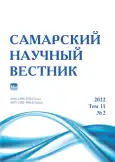Features of the genotypic structure of Scots pine glutamate dehydrogenase depending on the vital state of the tree
- Authors: Degtyareva A.P.1, Vnukova N.I.1, Kamalova I.I.1
-
Affiliations:
- All-Russian Research Institute of Forest Genetics, Breeding and Biotechnology
- Issue: Vol 11, No 2 (2022)
- Pages: 41-44
- Section: Biological Sciences
- URL: https://journals.rcsi.science/2309-4370/article/view/109827
- DOI: https://doi.org/10.55355/snv2022112105
- ID: 109827
Cite item
Full Text
Abstract
In the context of global warming, an important task is to find mechanisms for forest woody plants adaptation to changing environmental conditions. In steppe regions, this issue is particularly acute due to frequent droughts during the growing season. Scots pine is one of the main forest-forming species in Russia and is of great importance. The paper deals with the vital state of Scots pine plantations growing in the pessimal zone of the range in the steppe region, as well as the genotypic structure of the glutamate dehydrogenase locus. The allelic form of Gdh-1¹ of this enzyme is an embryonic semi-lethal for Scots pine and can act as a molecular marker of adaptation of this species to negative environmental conditions. It is known that organisms with semi-lethal genes in their genotype have a complex of compensatory mechanisms, which causes their increased resistance to adverse factors. The study sample was divided into two groups according to the level of living conditions: strong and weak. It was found that in the group of trees in the best vital condition, the proportion of genotypes containing embryonic half-life (Gdh-1¹) of scots pine prevails. Also, in the group of strong trees, the allele, which is an embryonic half-fly, is 79%, and in the group of weak trees – 39%, which is 1,9 times less.
Full Text
##article.viewOnOriginalSite##About the authors
Alina Petrovna Degtyareva
All-Russian Research Institute of Forest Genetics, Breeding and Biotechnology
Email: ali.serdyukova@yandex.ru
junior researcher of Ecological Genetics Laboratory
Russian Federation, VoronezhNatalya Ivanovna Vnukova
All-Russian Research Institute of Forest Genetics, Breeding and Biotechnology
Email: natalya.vnuckova@yandex.ru
researcher of Biotechnology Laboratory
Russian Federation, VoronezhIrina Ivanovna Kamalova
All-Russian Research Institute of Forest Genetics, Breeding and Biotechnology
Author for correspondence.
Email: kamairi@yandex.ru
candidate of biological sciences, leading researcher, head of Biochemistry, Molecular Genetics and Plant Physiology Laboratory
Russian Federation, VoronezhReferences
- Мохов И.И., Семёнов В.А. Погодно-климатические аномалии в российских регионах и их связь с глобальными изменениями климата // Метеорология и гидрология. 2016. № 2. С. 16-28.
- Кузнецова Н.Ф. Засухи в лесостепной зоне Центрально-Черноземного региона и критерии оценки их интенсивности // Известия Саратовского университета. Новая серия. Серия Науки о Земле. 2019. Т. 19, № 3. С. 142-148.
- Паршутина Л.П. О южной границе лесостепи в пределах Воронежской области // Известия Самарского научного центра РАН. 2012. Т. 14, № 1 (6). С. 1634-1637.
- Дегтярева А.П. Изменение климата в районе степей Центрального Черноземья в весенне-летний период // Global and Regional Research. 2021. Т. 3, № 4. С. 268-273.
- Кузмичев А.М., Овчаренко А.А. Оценка засухоустойчивости древесных насаждений в среднем Прихоперье // Известия Самарского научного центра РАН. 2012. Т. 14, № 1 (8). С. 1971-1974.
- Свинцова В.С., Кузнецова Н.Ф., Пардаева Е.Ю. Влияние засухи на генеративную сферу и жизнеспособность пыльцы сосны обыкновенной // Лесоведение. 2014. № 3. С. 49-57.
- Янбаев Ю.А., Музафарова А.А., Габитова А.А. Изоферментные маркеры и полиакриламидный диск-электрофорез в решении фундаментальных и прикладных задач лесной генетики и селекции: учеб. пособие. Уфа, 2011. 16 с.
- Струнников В.А. Новая гипотеза гетерозиса и ее научное и практическое значение // Вестник сельскохозяйственной науки. 1983. № 1 (316). С. 34-40.
- Камалова И.И., Камалов Р.М. Динамика генетической структуры локуса глутаматдегидрогеназы как маркер состояния насаждений сосны обыкновенной // Мониторинг и оценка состояния растительного мира: мат-лы междунар. науч. конф. Института экспериментальной ботаники им. В.Ф. Купревича НАН Беларуси (22-26 сентября 2008 г., г. Минск). Минск: Право и экономика, 2008. С. 167-168.
- Serdyukova A.P. The state of Scots pine plantations in the steppe Voronezh Region in drought conditions and under anthropogenic influence // IOP Conference Series: Earth and Environmental Science. Orenburg, 2021. doi: 10.1088/1755-1315/817/1/012098.
- Боголюбов А.С., Буйволов Ю.А., Кравченко М.В. Оценка жизненного состояния леса по сосне. М.: Экосистема, 1999. 25 с.
- Гончаренко Г.Г., Падутов В.Е., Потенко В.В. Руководство по исследованию хвойных видов методом электрофоретического анализа изоферментов. Изд. 2-е перераб. и доп. Гомель: БелНИИЛХ, 1989. 163 с.
- Сердюкова А.П. Сравнительный анализ признаков жизненного состояния Pinus sylvestris L. в условиях антропогенной нагрузки и на экологически благоприятной территории // Международный журнал гуманитарных и естественных наук. 2020. № 8 (47). С. 10-13.
Supplementary files








